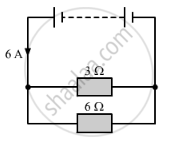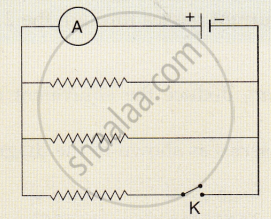Advertisements
Advertisements
Question
An electrical appliance has a rating 100 W, 120V. The resistance of element of appliance when in use:
Options
1.2 Ω
144 Ω
120 Ω
100 Ω
Solution
144 Ω
Given , Power (P) = 100 W
Potential difference , V = 120 volt
∴ Resistance , R = `("V"^2)/"P" = (120)^2/100 = 144 Ω`
APPEARS IN
RELATED QUESTIONS
Complete the following :-
(b)

Explain with diagram what is meant by the "series combination" and "parallel combination" of resistances. In which case the resultant resistance is : (i) less, and (ii) more, than either of the individual resistances?
A resistor has a resistance of 176 ohms. How many of these resistors should be connected in parallel so that their combination draws a current of 5 amperes from a 220 volt supply line?
In the circuit given below:

(a) What is the combined resistance?
(b) What is the p.d. across the combined resistor?
(c) What is the p.d. across the 3 Ω resistor?
(d) What is the current in the 3 Ω resistor?
(e) What is the current in the 6 Ω resistor?
In the diagram shown below, the cell and the ammeter both have negligible resistance. The resistor are identical.
You are given three resistances of 1, 2 and 3 ohms. Shows by diagrams, how with the help of these resistances you can get:
(i) 6 Ω
(ii) `6/1` Ω
(iii) 1.5 Ω
Calculate the equivalent resistance between the points A and B in Fig. if each resistance is 2·0 Ω.

A particular resistance wire has a resistance of 3 ohm per meter. Find the total resistance of three lengths of this wire each 1.5 m long, joined in parallel.
A particular resistance wire has a resistance of 3 ohm per meter. Find the potential difference of the battery which gives a current of 2 A in each of the 1.5 m length when connected in the parallel to the battery (assume that resistance of the battery is negligible).
How does the resistance of a metallic wire depend on the thickness of wire?
